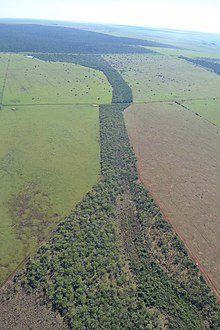
Back محمية الحياة البرية Arabic Екологичен коридор Bulgarian Passadís biològic Catalan Biokoridor Czech Spredningskorridor Danish Wildtierkorridor German Corredor ecológico Spanish Ökoloogiline koridor Estonian Igarobide ekologiko Basque گذرگاه حیات وحش Persian

A wildlife corridor, habitat corridor, or green corridor[1] is an area of habitat connecting wildlife populations separated by human activities or structures (such as roads, development, or logging). This allows an exchange of individuals between populations, which may help prevent the negative effects of inbreeding and reduced genetic diversity (via genetic drift) that often occur within isolated populations. Corridors may also help facilitate the re-establishment of populations that have been reduced or eliminated due to random events (such as fires or disease). This may moderate some of the worst effects of habitat fragmentation,[2] whereas urbanization can split up habitat areas, causing animals to lose both their natural habitat and the ability to move between regions to access resources. Habitat fragmentation due to human development is an ever-increasing threat to biodiversity,[3] and habitat corridors serve to manage its effects.
- ^ "Planning Portal – Glossary: G". Archived from the original on 1 December 2008.
- ^ Bond, M. (2003). "Principles of Wildlife Corridor Design. Center for Biological Diversity" (PDF). Biologivaldiversity.org. Archived (PDF) from the original on 6 June 2022. Retrieved 11 August 2015.
- ^ Fahrig, Lenore (28 November 2003). "Effects of Habitat Fragmentation on Biodiversity". Annual Review of Ecology, Evolution, and Systematics. 34: 487–515. doi:10.1146/annurev.ecolsys.34.011802.132419.
© MMXXIII Rich X Search. We shall prevail. All rights reserved. Rich X Search